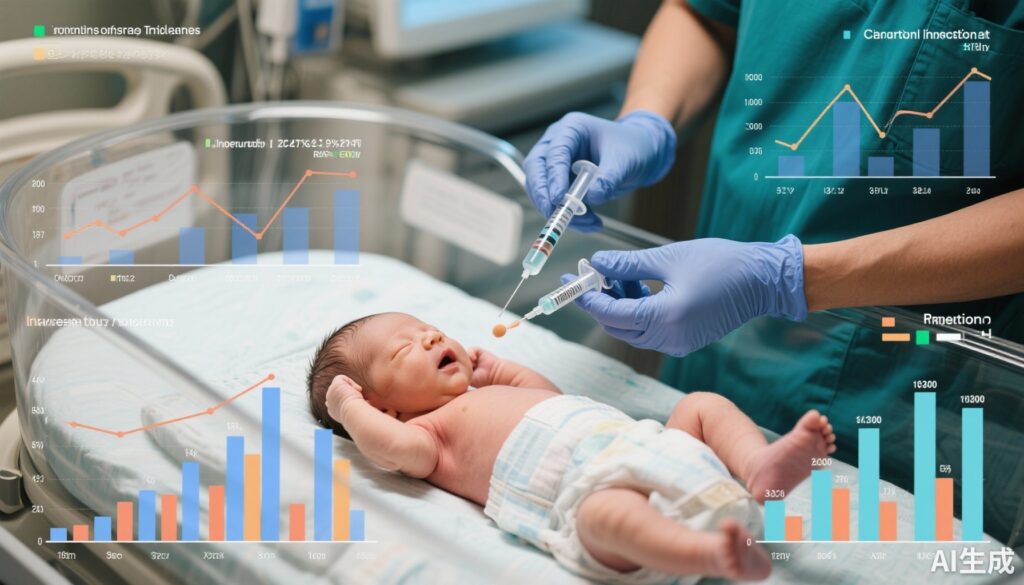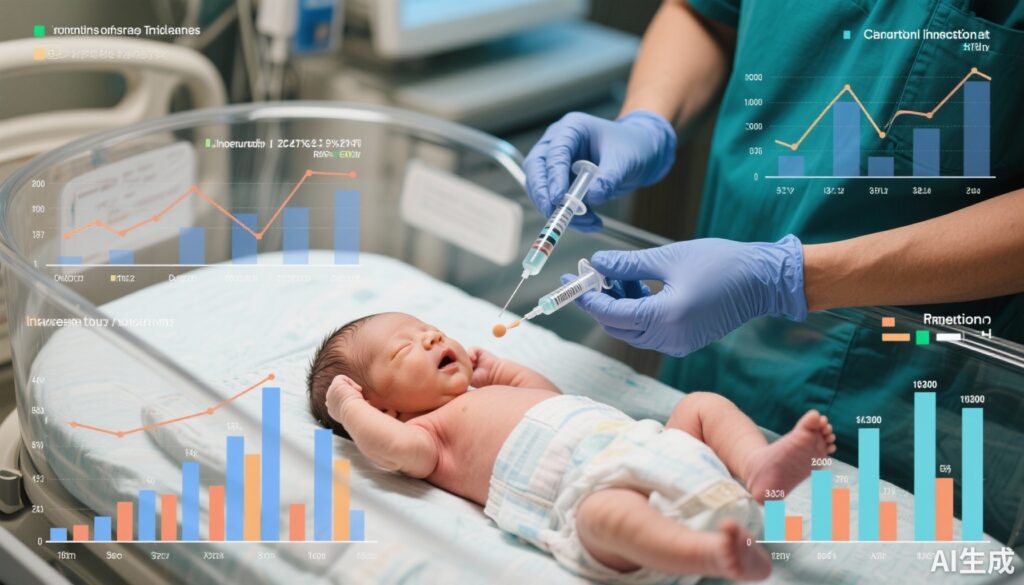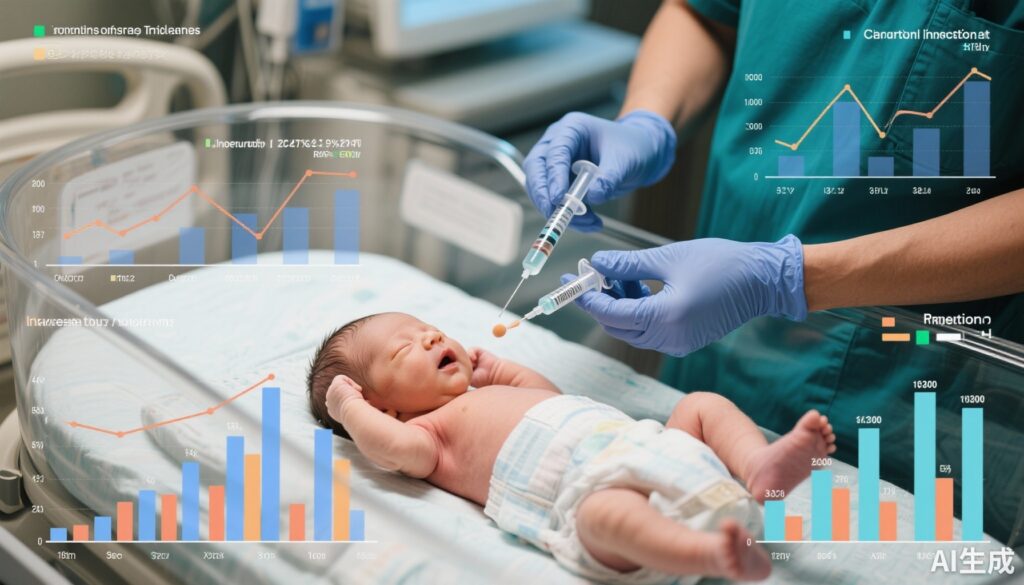Highlight
- Perinatal antibiotic exposure occurred in 28% of healthy term infants studied.
- There was no statistically significant association between perinatal or early infant antibiotic use and subsequent infection-related hospitalizations up to 6 years of age.
- Findings contribute to clarifying the uncertain role of intrapartum and neonatal antibiotic exposure in childhood infection susceptibility.
- Large multicenter cohort and rigorous statistical adjustments enhance the reliability of these conclusions.
Study Background
Antibiotic administration during pregnancy, childbirth (intrapartum), and early infancy is a common clinical practice to prevent or treat infections, aiming to safeguard maternal and neonatal health. However, concerns have emerged from epidemiological data suggesting that such early-life antibiotic exposures could alter the microbiome or immune development, potentially increasing susceptibility to infections during childhood. Despite accumulating observational evidence, the specific contribution of antibiotics given during the intrapartum period or within the first days of life to subsequent infection risk remains poorly defined. This knowledge gap limits clinicians’ ability to weigh risks and benefits when administering antibiotics around the time of birth.
Study Design
This investigation was a retrospective cohort study involving 13,919 healthy term infants drawn from 24 primary pediatric practices. The cohort was followed longitudinally up to 6 years of age. The primary exposure was defined as perinatal antibiotic use, specifically intravenous antibiotics administered either during the maternal hospital admission for childbirth (intrapartum) or to the infant within three days of birth. In addition, a secondary exposure group included early infant antibiotics, defined as any antibiotics administered to the infant during the first three months of life, inclusive of the perinatal period.
The primary outcome was infection-related inpatient hospital encounters documented during the follow-up period. The study employed multivariable-adjusted Cox proportional hazards models and marginal means/rates models to assess associations between antibiotic exposure and infection risk while controlling for potential confounders.
Key Findings
Among the cohort, 3,936 infants (28%) had documented perinatal antibiotic exposure. Over the 6-year follow-up, 1,294 children (9.3%) had a total of 1,619 inpatient admissions, of which 988 (61%) were related to infections.
Infection-related hospitalizations affected 6.7% of children exposed to perinatal antibiotics compared to 5.8% of unexposed children, yielding a risk difference of 1.2% (95% CI 0.3% to 2.1%, p=0.005). However, when adjusting for confounding factors, the association between perinatal antibiotic exposure and infection-related admissions was no longer statistically significant. The adjusted hazard ratio (aHR) from the Cox model was 1.16 (95% CI 0.95–1.51, p=0.15), and from the marginal rates/means model, the aHR was 1.22 (95% CI 0.98–1.51, p=0.08).
Similarly, early infant antibiotic exposure within the first three months did not show a statistically significant association with infection-related hospitalizations in adjusted analyses.
Expert Commentary
This study provides valuable clarification in an area complicated by potential confounding factors and heterogeneous definitions of antibiotic exposure. The initial unadjusted increased risk observed likely reflects that infants who receive perinatal antibiotics may differ in important clinical ways, such as increased baseline risk for infections or other comorbidities.
Adjusted analyses indicate no definitive causal relationship between early antibiotic exposure and increased risk of serious childhood infections requiring hospitalization. These findings align with current understanding that judicious antibiotic use during delivery and early infancy remains a critical component of preventive care without demonstrable long-term infectious risk when appropriately applied.
Limitations of the study include its retrospective observational design and reliance on electronic health record data, which may not capture all antibiotic exposures or outpatient infection events. Moreover, the cohort consisted of healthy term infants, which may limit generalizability to preterm or medically complex neonates. Further prospective studies with microbiome and immune function assessments could elucidate potential subclinical or nuanced effects of early antibiotic exposure.
Conclusion
In this large, multicenter retrospective cohort, intravenous antibiotic exposure in the perinatal period or early infancy was not associated with a statistically significant increase in subsequent infection-related hospitalizations during early childhood. These results support the continued use of perinatal antibiotics when indicated, addressing a critical clinical question amid concerns regarding antibiotic stewardship and childhood health outcomes.
Future research should explore the biological mechanisms underlying antibiotic-microbiome-immune interactions and investigate vulnerable populations to refine clinical guidelines.
Funding and ClinicalTrials.gov
This study was supported by the Eunice Kennedy Shriver National Institute of Child Health and Human Development, part of the National Institutes of Health, under grant K23 HD088753. There is no mention of clinical trial registration.
References
1. Coggins SA, Quarshie W, Grundmeier RW, Shu D, Gerber JS, Dhudasia MB, Puopolo KM, Mukhopadhyay S. Perinatal antibiotic exposure and risk of childhood infections: a retrospective cohort study. Lancet Regional Health Americas. 2025 Oct 16;52:101264. doi: 10.1016/j.lana.2025.101264. PMID: 41141570; PMCID: PMC12553004.
2. Zimmermann P, Curtis N. The effect of antibiotics on the composition of the intestinal microbiota – a systematic review. J Infect. 2019 Jan;79(6):471-489. doi:10.1016/j.jinf.2019.07.010.
3. Fouhy F, Guinane CM, Hussey S, Wall R, Ryan CA, Dempsey EM, Murphy B, et al. High-throughput sequencing reveals the incomplete, short-term recovery of infant gut microbiota following parenteral antibiotic treatment with ampicillin and gentamicin. Antimicrob Agents Chemother. 2012 Nov;56(11):5811-20. doi:10.1128/AAC.01001-12.





